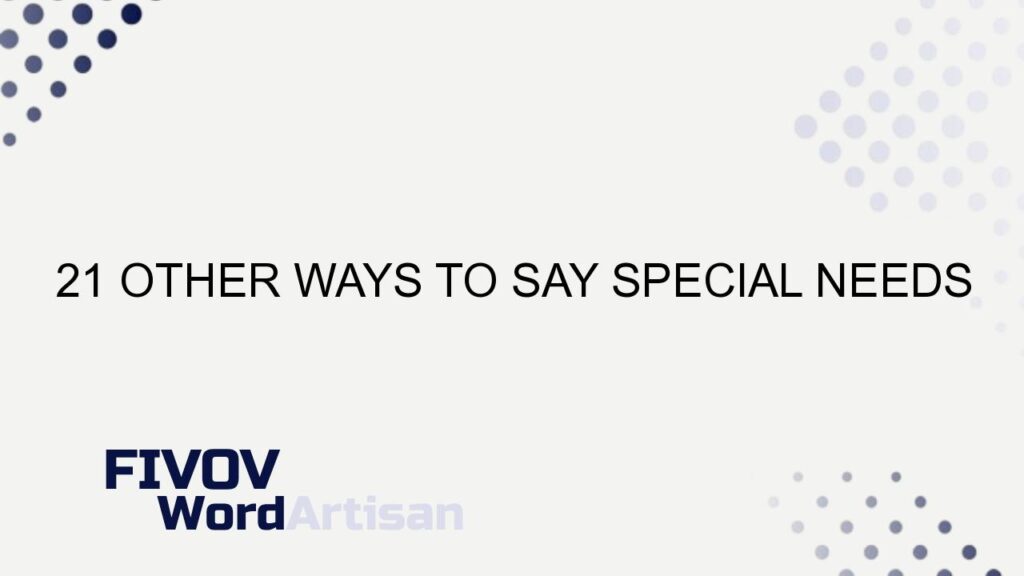Are you attempting to determine if something is feasible but find yourself needing to inquire first? Maybe you’re concerned that the phrase “special needs” might not be the most professional way to ascertain if an action can be undertaken.
MY LATEST VIDEOS
Well, you’ve come to the right place to find out more. This article will show you how to professionally say “special needs” when you need it.
Other Ways to Say “Special Needs”
When it comes to discussing special requirements or individualized support, there are several alternatives to the term “special needs.” Using different vocabulary can help avoid stigmatization and promote more inclusive and respectful communication. Let’s explore 21 other ways to express the concept of “special needs”:
1. Unique Requirements
2. Individualized Support
3. Differing Abilities
4. Exceptional Needs
5. Personalized Assistance
6. Distinctive Accommodations
7. Specific Assistance
8. Tailored Support
9. Customized Services
10. Extraordinary Considerations
11. Unique Care
12. Individualized Provision
13. Exceptional Circumstances
14. Differentiated Assistance
15. Personalized Care
16. Tailored Accommodations
17. Customized Supports
18. Peculiar Needs
19. Exceptional Requirements
20. Individualized Solutions
21. Specialized Assistance
By incorporating these alternative expressions into your vocabulary, you can convey the necessary sensitivity and respect when discussing the diverse and unique requirements of individuals.
Understanding the Importance of Inclusive Language
Effective communication is essential in creating an inclusive and supportive environment for individuals with diverse needs. Using respectful and inclusive language ensures that everyone feels valued and understood. By recognizing the significance of inclusive language, we can foster a more welcoming and empathetic society.
Why Using Inclusive Language Matters
Inclusive language promotes dignity, respect, and equal opportunities for all individuals. It acknowledges the diverse experiences and challenges that people may face and emphasizes the value of every individual. When discussing topics related to special requirements, it is vital to use language that fosters understanding, inclusivity, and empathy.
How to Incorporate Inclusive Language
When addressing the needs of individuals with unique requirements, it is crucial to choose language that is respectful, affirming, and empowering. Here are some guidelines for incorporating inclusive language:
1. Focus on the Individual
Recognize the person first and foremost. Instead of using labels or categories, prioritize individual identity and agency.
2. Emphasize Abilities and Strengths
Highlight the individual’s capabilities and strengths while acknowledging any additional support they may require.
3. Avoid Stereotypes and Assumptions
Be mindful of stereotypical language or assumptions that may perpetuate stigma or misconceptions about individuals with diverse needs.
4. Use Person-First Language
Place the person before the condition or requirement when describing individuals with unique needs. For example, “a person with exceptional abilities” instead of “an exceptional person.”
FAQs
What is the Significance of Using Inclusive Language?
Inclusive language promotes respect, dignity, and understanding for individuals with diverse needs. It fosters a culture of empathy and inclusivity.
How Can Inclusive Language Benefit Communication?
Inclusive language enhances communication by creating a more supportive and respectful environment for individuals with varying requirements. It promotes empathy and understanding.
What Are Some Examples of Inclusive Language?
Examples of inclusive language include person-first language, emphasizing individual strengths, and avoiding stereotypes or stigmatizing terms.
Conclusion
In conclusion, finding alternative ways to express special needs can contribute to a more inclusive and respectful dialogue surrounding individual requirements and support. By understanding the importance of inclusive language and incorporating it into our communication, we can create a more supportive and empathetic environment for individuals with diverse needs. Remember to prioritize language that acknowledges the individual, emphasizes strengths, and avoids stigmatization. Let’s strive to use language that fosters inclusivity, respect, and understanding for all individuals.




